
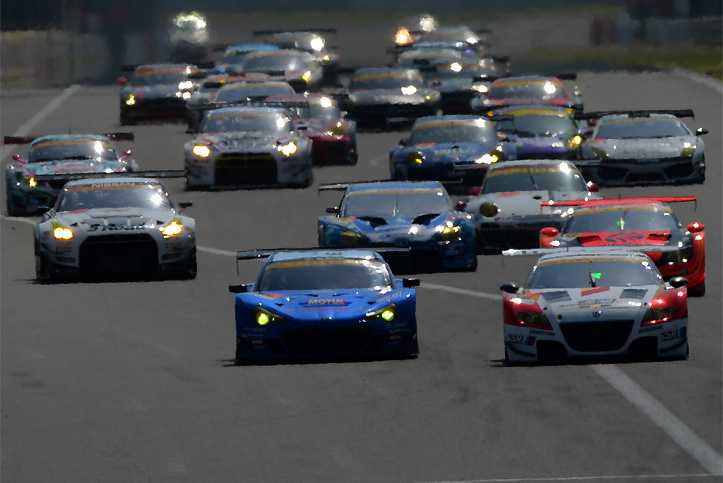
OFF SEASON SPECIAL -5-
First wins everywhere in 2013! Japan’s own JAF-GT300 cars.
The exercise to look back the 2013 SUPER GT racing cars has come down to GT300 coverage. In continuation from the first write-up, which covered the FIA GT3 cars, this time we will take up JAF-GT300 cars. FIA GT3 from the previous edition is the GT regulation defined by FIA (Federation Internationale de l'Automobile) where as JAF-GT300 is the regulation defined by JAF (Japan Automobile Federation) for SUPER GT’s very own GT300 class vehicles. There is some misperception, but this is not a technical regulation only for Japanese (domestic) cars. An overseas car can be a JAF-GT300 vehicle if it is modified into a racing car accordingly to the JAF-GT300 regulation, and, as a matter of fact, that was the main stream a few years ago. However, FIA GT3 car racing has gained popularity at overseas in recent years, and there are more models in this category than before. With that change, requests were raised by few teams in the series to use an FIA-GT3 car in the SUPER GT as well, making the two technical regulations to exist in the series.
One of the highlights of the JAF-GT300 regulation is the vastness of modification and setting ranges. FIA GT3 regulation barely allows any changes from the complete car built by respective manufacturer. Contrastingly, teams can change the location of engine or even replace the whole suspension in the JAF-GT300 regulation. This is why the JAF-GT300 cars are said to have advantage in cornering ability. You will soon find out from the explanation below, but, unlike the FIA-GT3 cars which did not change much during the season, changes were made on the JAF-GT300 cars in the aerodynamics parts, etc. Of course, there should also be changes in suspension, gear ratio, and engine too, but they are not visible in the exterior photos.
On the other hand, the engine power is limited to about 300 horsepower – this is where the name of GT300 class originated from. Due to this, it is not rare to see an FIA GT3 vehicle, mostly with over 500 horsepower, overtaking a JAF-GT300 car on a straightway. But the difference in power would have adverse effect on the fuel efficiency, and the JAF-GT300 vehicles exert their advantage well in long-distance races. In 2013, 500km race at Round 2 Fuji and 1000km race at Round 5 Suzuka are won by a JAF-GT300 car. Moreover, hybrid cars were showing performances comparable to FIA GT3 cars by utilizing the motor as a power generator in the acceleration in addition to its advantage in the fuel efficiency.
Although none of the JAF-GT300 cars came close to score a win in 2012, CR-Z GT claimed the championship in 2013, where JAF-GT300 cars scored four wins out of eight races (one win each by PRIUS GT and BRZ and two wins by CR-Z GT) equaling the number of wins against the FIA GT3 vehicles. In addition, CR-Z GT had also won the Asian Le Mans Series Round 2 Fuji, an inter-category race which is not a regular series race.
○Honda CR-Z GT [Japan]
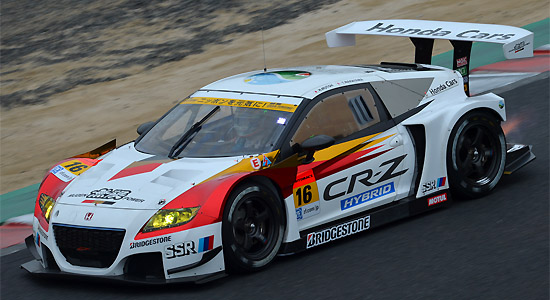
Rd.1 OKAYAMA No.16 MUGEN CR-Z GT
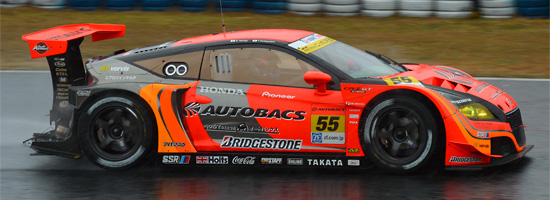
Rd.1 OKAYAMA No.55 ARTA CR-Z GT
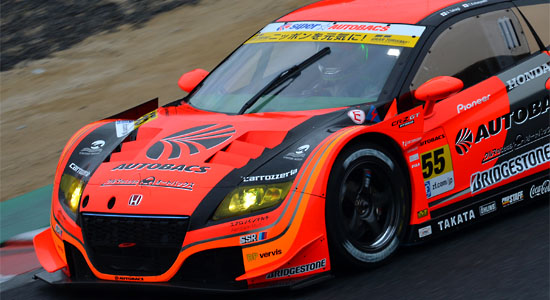
Rd.1 OKAYAMA No.55 ARTA CR-Z GT
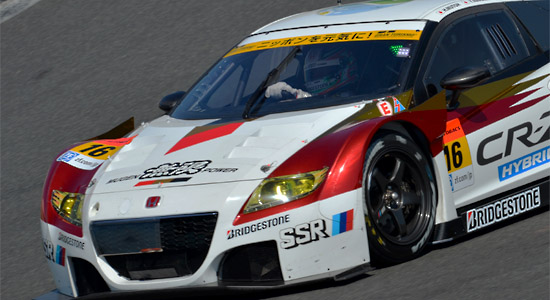
Rd.2 FUJI No.16 MUGEN CR-Z GT
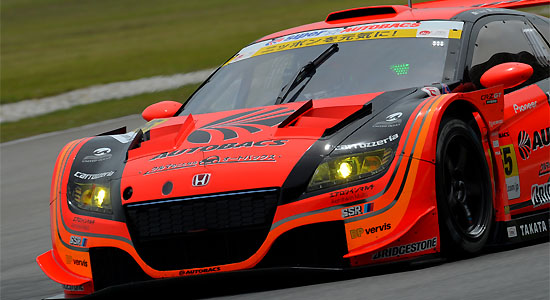
Rd.3 SEPANG No.55 ARTA CR-Z GT
In 2013, No.16 MUGEN CR-Z GT became the first hybrid car to win the SUPER GT championship. In its debut year of 2012, it started competing in the series in the middle of the season from the Round 4 and was not able to reach a victory, but with the advancement of state-of-the-art technology to combine engine and motor in this season, it was able to battle out neck to neck with the FIA GT3 cars in not only the cornering ability, which the JAF-GT300 cars have advantage, but also on the straights.
There were no significant changes in the appearance outside throughout the season, but minor changes were seen on the aerodynamics at the front area at the high-speed track of Fuji and Sepang in the heat. Canards (small wing) on the front bumper seen at the Round 1 Okayama were removed at the Round 2 Fuji. But it was brought back at the Round 3 Sepang. Boards, like screens, were placed to surround the slits on the hood. It was for the heat (to avoid overheating) and was effective in facilitating the air to flow through. Air intake was added on the roof for ventilation in inside of the car to reduce air temperature around the driver.
○TOYOTA PRIUS GT [Japan]
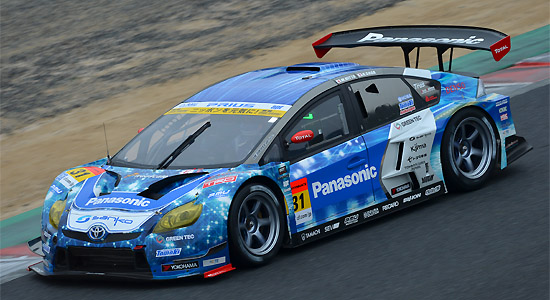
Rd.1 OKAYAMA No.31 Panasonic apr PURIUS GT
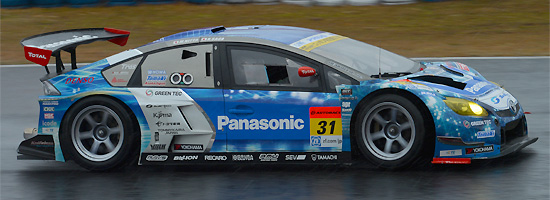
Rd.1 OKAYAMA No.31 Panasonic apr PURIUS GT
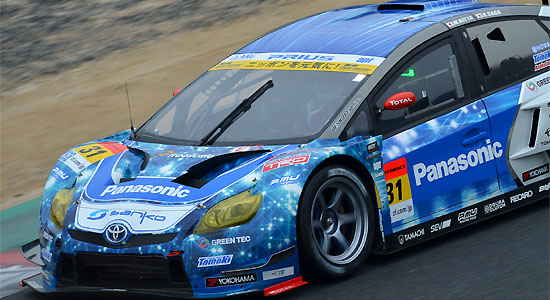
Rd.1 OKAYAMA No.31 Panasonic apr PURIUS GT
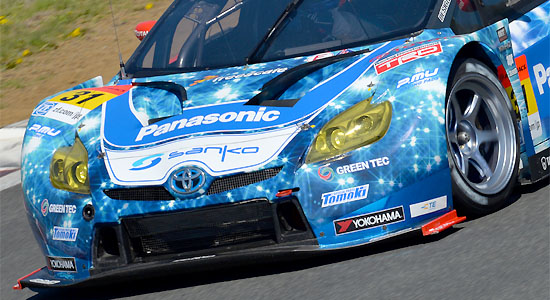
Rd.2 FUJI No.31 Panasonic apr PURIUS GT
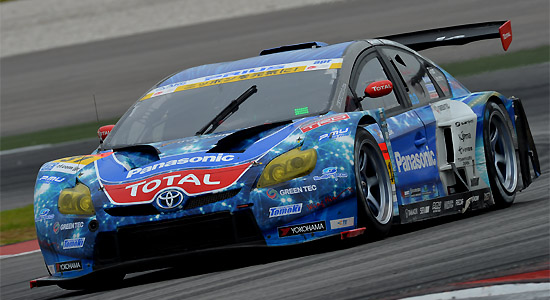
Rd.3 SEPANG No.31 Panasonic apr PURIUS GT
PRIUS GT began its participation to the series from the season opener in 2012. As the pioneer hybrid racing car in the SUPER GT, it became the first hybrid car to win a SUPER GT race at the Round 2 Fuji in 2013. Besides winning, CR-Z GT bears a theme of developing a hybrid system exclusive for racing, but what is challenged through PRIUS GT is that, by using many parts from the production model hybrid car, to explore how far a production model hybrid can accommodate to the ultimate motorsports, which were totally different approach compared to CR-Z GT.
Changes were seen on PRIUS GT also at the season opener at Okayama, Round 2 Fuji, and Round 3 Sepang with front canards being put on and off, however, the air intake to the cockpit of the car remained the same even at Sepang. This was because the air conditioner installed in the car was working effectively. Controlling system of the hybrid was placed in the passenger’s seat area, and, with the electronics device being sensitive to the heat, the cockpit of PRIUS GT was said to be comfortable even in the summer. Story tells that such comfort held back drivers from getting off the car in between the practice sessions.
○SUBARU BRZ GT300 [Japan]
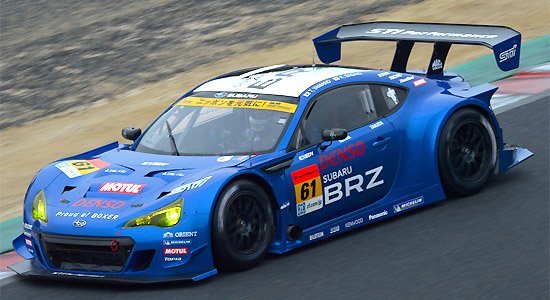
Rd.1 OKAYAMA No.61 SUBARU BRZ R&D SPORT
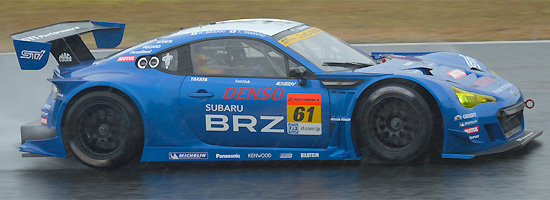
Rd.1 OKAYAMA No.61 SUBARU BRZ R&D SPORT
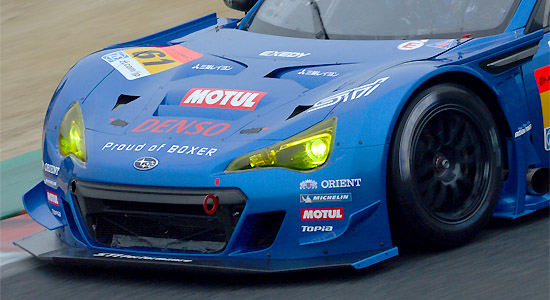
Rd.1 OKAYAMA No.61 SUBARU BRZ R&D SPORT
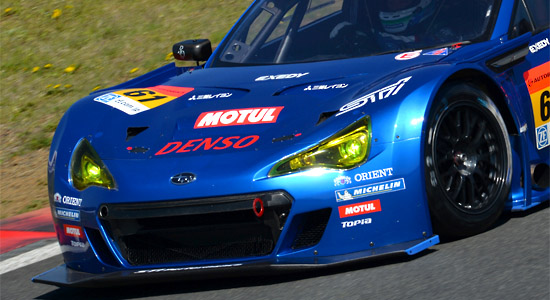
Rd.2 FUJI No.61 SUBARU BRZ R&D SPORT
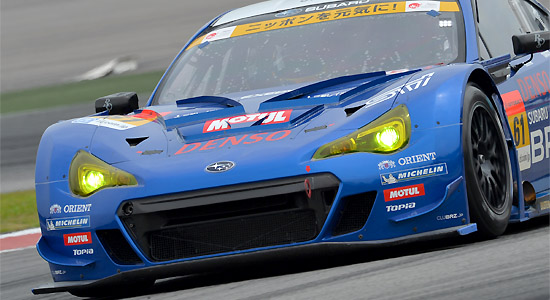
Rd.3 SEPANG No.61 SUBARU BRZ R&D SPORT
BRZ debut in 2012, but the first year was a frustrating year for BRZ too. But in 2013, based on the data from previous year, major modification was done, which even involved a complete reengineering of chassis, and a decision was made to switch tires to Michelin, making the team to become the only team to wear Michelin in GT300. Not only the brand but the size of tire became wider than the year before, requiring the front and back fenders to change significantly to a design which looked similar to GT500 vehicles. Nonetheless, it was a breakthrough for BRZ, marking five pole positions, breaking the record of most pole positions in a year in SUPER GT, and grabbing the first win of BRZ at the Round 5 Suzuka.
Appearance on the outside did not change much during 2013, similar to other two models, and just few minor changes were made to suit characteristics of different circuits (installing/uninstalling front canards). Five pole positions are probably a proof of being able to adapt to any circuits and get the target time by one attempt, which is known to be a feature of JAF-GT300 cars. Also, it is speculated that the win at the 1000km race was just a result of having superior fuel efficiency despite a turbo engine and successfully adapting to rather high-speed, technical track of Suzuka.
| 4/13-14 | Round1 OKAYAMA | |
| 5/03-04 | Round2 FUJI | |
| 6/01-02 | Round3 SUZUKA | |
| 8/03-04 | Round4 FUJI | |
| 9/21-22 | Round6 SUGO | |
| 10/19-20 | Round7 AUTOPOLIS | |
| 11/02-03 | Round8 MOTEGI | |
| 12/07-08 | Round5 SUZUKA |